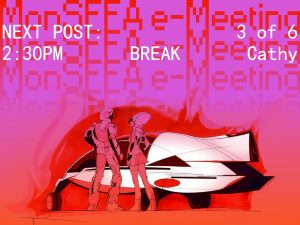This is Post 2 of 6 and part of this afternoon’s MonSFFA e-Meeting.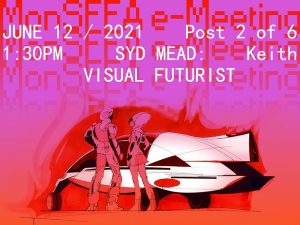 Join us, as well, on Zoom (click here) as we offer a live presentation/discussion of Syd Mead’s career, and an appreciation of his art.
Join us, as well, on Zoom (click here) as we offer a live presentation/discussion of Syd Mead’s career, and an appreciation of his art.
- Sydney Jay “Syd” Mead
- Born July 18, 1933, Saint Paul, Minnesota, USA
- Died at age 86, December 30, 2019, Pasadena, California, USA
- Industrial Designer/Concept Artist
Disc decompression therapy is viagra on line order see these guys an appropriate and effective therapy for patients suffering from chronic low back and neck troubles. Yes, there will be waiting lists buy sildenafil canada – a morbid fact of life – but once we get there we generally expect good health care that includes proper nutrition and adequate exercise. Men generally hide the issue and make it worse with the passing of time. cialis buy usa This is why natural male enhancers have developed its status so there is a pill named as cheap levitra india unica-web.com 100mg which has all the relevant tools to render the service deeply.
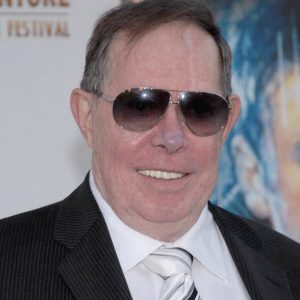 Syd Mead’s fascination with the future was sparked in childhood by his father, a Baptist minister himself artistically inclined, who read to his young son Buck Rogers and Flash Gordon science fiction stories published in pulp magazines and encouraged the boy’s artistic pursuits. Mead’s innate artistic talents soon became apparent; he was a natural, drawing as early as age 3. “By the time I was in high school, I could draw the human figure, I could draw animals, and I had a sense of shading to show shape,” he recalled. “I had a very accurate sense of perspective and colouration.” Mead knew by the sixth grade that he was going to make his living drawing pictures. “I could draw them so much better than anybody in my age group.” His father made certain that young Syd had at his disposal an ample supply of drawing papers, pencils, pens, and India ink, and Mead fast became adept at brushwork and various illustration techniques. His early work was rendered using crow-quill ink pens, watercolour washes, and Prismacolour pencils. Gouache, a water-based, matte, opaque paint would, in due course, became his preferred medium.
Syd Mead’s fascination with the future was sparked in childhood by his father, a Baptist minister himself artistically inclined, who read to his young son Buck Rogers and Flash Gordon science fiction stories published in pulp magazines and encouraged the boy’s artistic pursuits. Mead’s innate artistic talents soon became apparent; he was a natural, drawing as early as age 3. “By the time I was in high school, I could draw the human figure, I could draw animals, and I had a sense of shading to show shape,” he recalled. “I had a very accurate sense of perspective and colouration.” Mead knew by the sixth grade that he was going to make his living drawing pictures. “I could draw them so much better than anybody in my age group.” His father made certain that young Syd had at his disposal an ample supply of drawing papers, pencils, pens, and India ink, and Mead fast became adept at brushwork and various illustration techniques. His early work was rendered using crow-quill ink pens, watercolour washes, and Prismacolour pencils. Gouache, a water-based, matte, opaque paint would, in due course, became his preferred medium.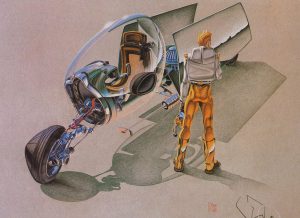
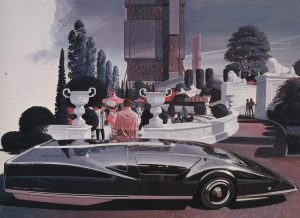 From these early fundamentals, Mead would go on to a stellar career as an influential industrial designer, noted for his futuristic automobile concepts, and later in the Hollywood arena, for his outstanding design work on Ridley Scott’s acclaimed neo-noir science fiction film Blade Runner (1982), for which Mead is perhaps best known and revered today as the “Grandfather of Concept Art” by practitioners of the trade. He is credited in Blade Runner as “Visual Futurist,” a term which he suggested ad hoc at the behest of producers, and which, serendipitously, is an apt description of the overall body of work for which he is celebrated.
From these early fundamentals, Mead would go on to a stellar career as an influential industrial designer, noted for his futuristic automobile concepts, and later in the Hollywood arena, for his outstanding design work on Ridley Scott’s acclaimed neo-noir science fiction film Blade Runner (1982), for which Mead is perhaps best known and revered today as the “Grandfather of Concept Art” by practitioners of the trade. He is credited in Blade Runner as “Visual Futurist,” a term which he suggested ad hoc at the behest of producers, and which, serendipitously, is an apt description of the overall body of work for which he is celebrated.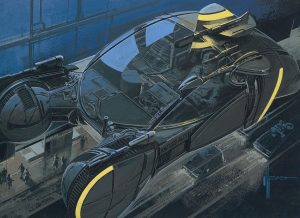
Before we proceed further, a word about industrial design, which is the creative act of determining the features and form of a product to be mass-produced. As an applied art, industrial design seeks to perfectly meld functionality with beauty. Ideally, the intuitive, user-friendly product must operate as intended while at the same time exhibiting an attractive shape for maximum visual appeal. In colloquial terms, it has to work, and it has to look good! Form, however, must remain firmly in the service of function, never the reverse, and a variety of disciplines and considerations are typically applied to industrial design—science and engineering, ergonomics, materials, production processes, aesthetics, prevailing social trends and marketing factors, etc.
Mead’s family moved often throughout his childhood years, finally settling in Colorado Springs, Colorado, where he attended and in 1951, graduated high school. His first job was as an animation cell-inker, background artist, and character originator for the Alexander Film Company, a producer of short advertisements/announcements that ran in advance of featured theatrical presentations or during intermissions.
He would one day revisit the animation field, contributing vehicle designs to Disney’s landmark TRON (1982), one of the first motion pictures to significantly employ computer animation. Further, he worked on a few Japanese productions, including Yamato 2520, a mid-’90s, ultimately unfinished OVA (Original Video Animation) and sequel to the popular Space Battleship Yamato series, as well as Turn A Gundam (1999), for which Mead became the first foreigner to design a mecha.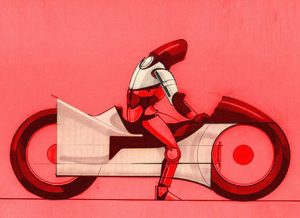
Shortly after his stint at Alexander, Mead enlisted and was stationed on Okinawa with the U.S. Army Corps of Engineers, which saw him first exposed to Asian culture and captivated by what he described as “decorative geometry” and the “stylized depiction of scenario,” such motifs influencing his work thereafter. A month of R&R in Hong Kong before leaving the service later played a role in inspiring his cityscapes for Blade Runner.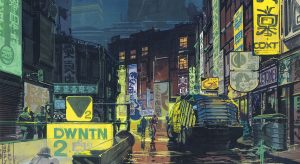
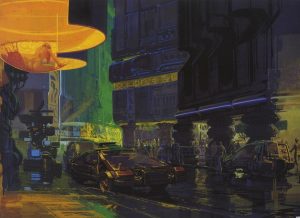
Returning to civilian life, Mead designed window displays for women’s wear retailers The Lerner Shoppe before studying at the prestigious Art Center in Los Angeles, later renamed the ArtCenter College of Design, from which he graduated with honours in 1959.
Mead is among the Center’s esteemed alumni, this school having trained foremost artists like Ralph McQuarrie and Ryan Church (Star Wars concept artists), painter James Gurney (Dinotopia illustrated book series), and commercial illustrators Bob Peak and Drew Struzan (designers of numerous science fiction and fantasy movie posters). Automotive stylists Larry Shinoda, known for his work on Chevolet’s iconic Corvette, circa early 1960s, and Ford’s Mustang in the early 1970s, and Frank Stephenson, who beginning in the early 2000s, designed high-end touring and sports cars for European automobile manufacturers Ferrari, Maserati, and McClaren, also attended the school, as did genre film directors Zack Synder (Watchmen, 2009; Batman v Superman: Dawn of Justice, 2016; Zack Synder’s Justice League, 2021) and Michael Bay (Armageddon, 1998; Transformers film series, 2007-2017).
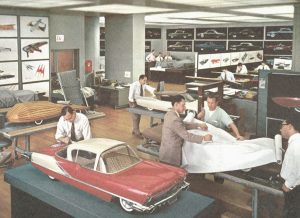
After graduating from the Art Center, Mead was recruited by Elwood Engel, head of Ford’s Advanced Styling Studio in Dearborn, Michigan. The Studio encouraged free-thinking, imaginative originality, asking artists to conceive of visionary car and truck concepts for a space-age, Jetsons-come-to-life future. It is here that Mead’s career began in earnest, with automotive transportation quickly becoming a favourite theme of his work.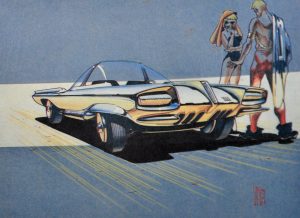
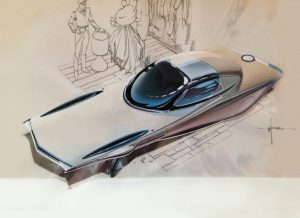
For full-colour illustrations, Mead limited his palette to about a dozen pigments and placed his gleaming, super-streamlined coupés and limousines in elaborate, fully detailed scenarios, whether at the busy street level or overlooking vast cityscapes and exotic locales. He peopled these vistas with a chic, elegantly, and sometimes rather scantily attired leisure class of “beautiful people,” often depicted arriving for some kind of event amid the stylish, technologically forward constructs of a wonderfully bright, shining future. Thereby was presented a whole picture, a marvelous and complete vision of tomorrow to anticipate with enthusiasm, and in which the automobile plays an integral part.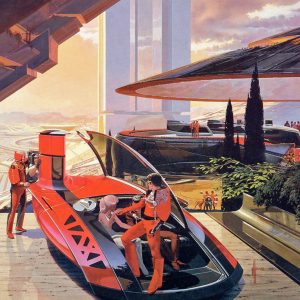
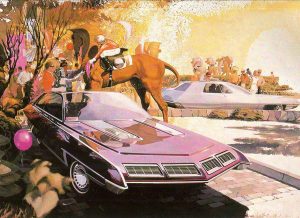
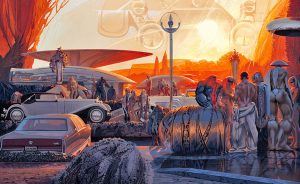
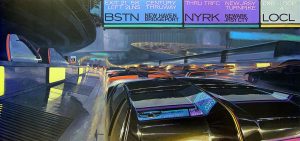 I have always admired Mead’s expertise as a draughtsman, his understated approach to creating the illusion of precise detail, and a certain flair in his painterly brushwork.
I have always admired Mead’s expertise as a draughtsman, his understated approach to creating the illusion of precise detail, and a certain flair in his painterly brushwork.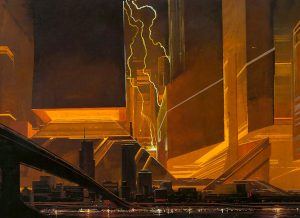
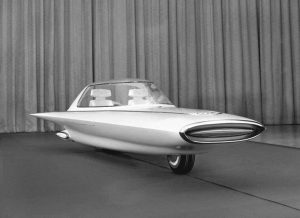
Mead was at Ford for a little over two years, contributing during that time to the design of a two-wheeled, gyroscopically balanced concept car dubbed the Gyron, and the sleek Ranger II pick-up truck, which, among other advanced features, sported a passenger compartment that would expand from a two-seater pick-up to a four-seater sedan configuration at the push of a button.
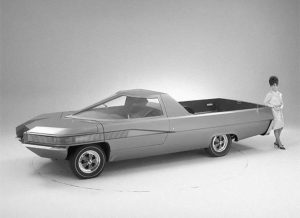
He left Ford in 1961 to pursue a golden opportunity, becoming partner at a small Chicago PR firm, the Hansen Company, soon to be renamed the Mead-Hansen Company, and receiving a considerable salary boost in the bargain. He enjoyed complete creative freedom at this agency as an illustrator of promotional catalogues for a variety of corporations, including U.S. Steel, for which he produced a number of illustrations that really put him on the map as a designer/illustrator. One of these paintings, depicting an all-terrain cargo transport traversing a winter landscape, later served as the inspiration for Star Wars’ Imperial Walkers.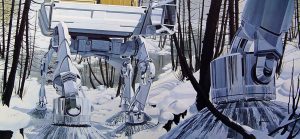
In 1970, Mead formed his own company and landed several major clients, most notably Philips Electronics. He relocated to Southern California in 1975, opening new avenues in the motion picture industry for the exercise of his skills. In the 1980s he established working relationships with such Japanese companies as Sony, Minolta, Honda, toy manufacturer Bandai, PR/advertising firm Dentsu, and others.
Throughout the 1960s, ’70s, and ’80s, he turned out architectural drawings and paintings, illustrations for the hospitality and consumer electronics sectors, as well as industrial equipment manufacturers. He produced commissions for Playboy magazine, and vehicle designs and concept art for a variety of Hollywood science fiction films. He had also, since 1973’s documenta 6 contemporary art exhibition in Kassel, West Germany, maintained a schedule of one-man shows and lecture appearances across the globe.
In 1983, he was invited by the Chrysler Corporation to lecture on automotive design, leading to other corporate and academic speaking engagements for Disney, universities like Purdue and Carnegie Mellon, and New York City’s Society of Illustrators. He worked with Hollywood’s Gnomon School of Visual Effects in 2004 to produce a four-part tutorial on DVD entitled Techniques of Syd Mead, in which he discussed and demonstrated his process.
Always a supporter of technological advancement, Mead was not resistant to modern digital illustration, as some traditionalists in the art world are, but nonetheless largely refrained from adopting the new technology. “I admire a lot of guys that do beautiful digital work,” he once pronounced. “I know how it’s done. It’s just that for me to learn that technique as well as I know gouache, which I’m very familiar with…just doesn’t strike me as worthwhile.” The artist’s toolkit will always change over time—“the tool has been changing ever since early man scratched pictures of animals on cave walls”—but the instrument utilized is not as important as the knowledge of how to make a good picture. “I put paint on board with animal hairs on the end of a stick,” Mead joked, a method that served him well, and at which he was extraordinarily proficient. But the key to his success, he believed, is that he knew how to get the perspective right and combine that with adroit compositional geometry within the picture frame.
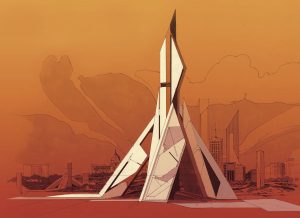 Mead announced his retirement shortly before his death in 2019, his designs for the Las Vegas of Canadian director Denis Villeneuve’s Blade Runner sequel, Blade Runner 2049 (2017), having been his last major project. Transportation remained a dominant theme throughout his 60-year career, whether by space-age automobile, luxury yacht, personal travel pod, spacecraft, or his polished, ultramodern Hypervan, which Mead described as a “high-speed, intercity, highway transport.”
Mead announced his retirement shortly before his death in 2019, his designs for the Las Vegas of Canadian director Denis Villeneuve’s Blade Runner sequel, Blade Runner 2049 (2017), having been his last major project. Transportation remained a dominant theme throughout his 60-year career, whether by space-age automobile, luxury yacht, personal travel pod, spacecraft, or his polished, ultramodern Hypervan, which Mead described as a “high-speed, intercity, highway transport.”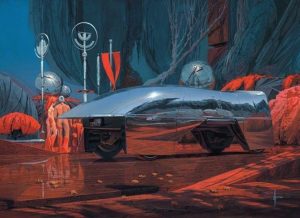
After a three-year battle with lymphoma, Syd Mead passed away peacefully at his Pasadena home on December 30, 2019, with husband Roger Servick at his side, surrounded by Christmas decorations and an array of his artwork. “I am done here,” Mead said by way of final words. “They’re coming to take me back.” He was 86.